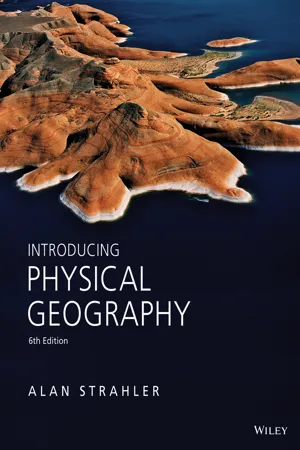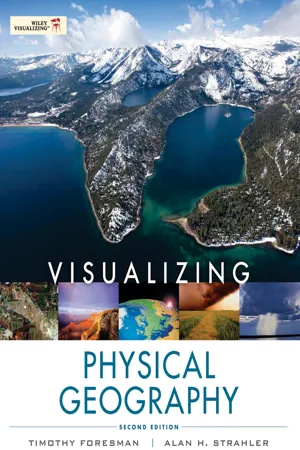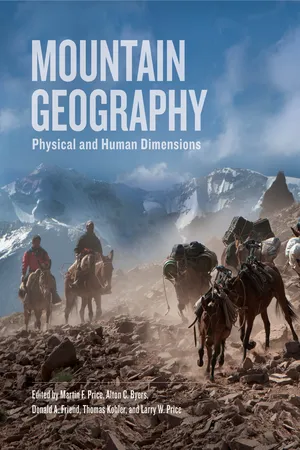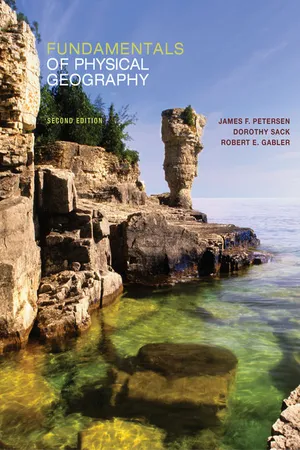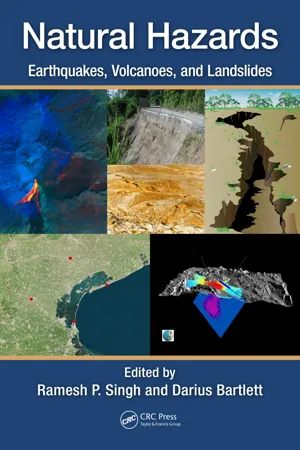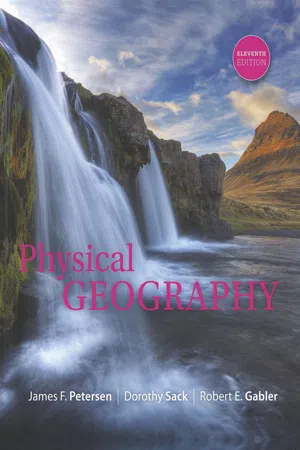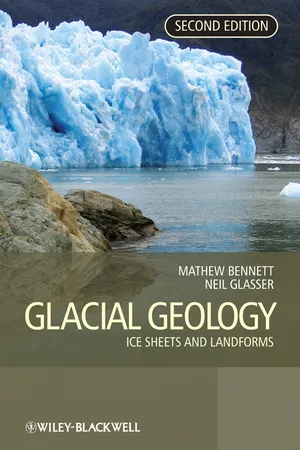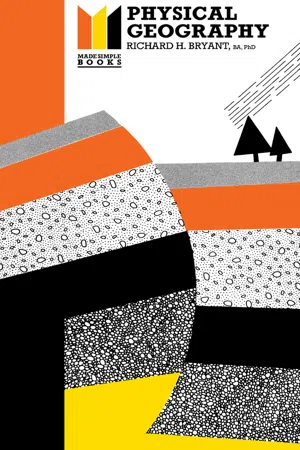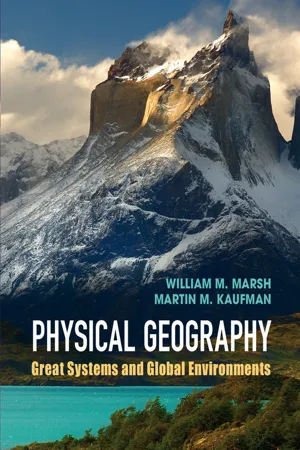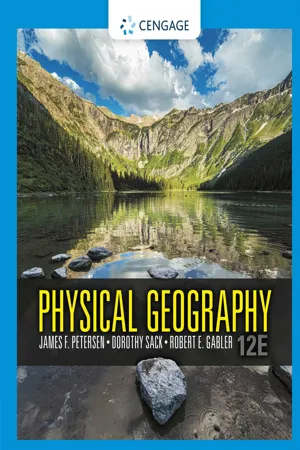Geography
Erosional Landforms
Erosional landforms are physical features on the Earth's surface that have been shaped by the processes of erosion, such as the wearing away of rock and soil by water, wind, or ice. Examples of erosional landforms include valleys, canyons, cliffs, and sea stacks. These landforms are the result of the gradual removal of material from the Earth's surface over time.
Written by Perlego with AI-assistance
Related key terms
1 of 5
10 Key excerpts on "Erosional Landforms"
- eBook - PDF
- Alan H. Strahler(Author)
- 2013(Publication Date)
- Wiley(Publisher)
The sediment is finally deposited downstream, where it build ups into plains, levees, fans, and deltas. Waves, glacial ice, and wind also shape unique landforms, but these processes are restricted to certain areas on the globe, as we will see in later chapters. The landforms shaped by the progressive removal of bedrock are called Erosional Landforms . Fragments of soil, regolith, and bedrock that are removed from the parent rock mass are transported and deposited elsewhere, where they take shape as an entirely differ- ent set of surface features—the depositional landforms (Figure 15.1). SLOPE EROSION Fluvial erosion starts on the uplands as soil erosion. When raindrops hit bare soil, their force lifts soil particles, which fall back into new positions, causing splash ero- sion (Figure 15.2). A torrential rainstorm can disturb as much as 225 metric tons of soil per hectare (about 100 U.S. tons per acre). On a sloping ground surface, splash erosion shifts the soil slowly downhill. The soil surface also becomes much less capable of absorbing water. This important effect occurs because the natural soil openings ost of the landforms we see around us are sculpted by running water as it erodes, trans- ports, and deposits sediment. What causes slopes to erode, and what happens to eroded particles? How do streams build their beds and wear away their banks? How do stream valleys evolve over time? Under what conditions do streams form floodplains and meanders? These are some of the questions we will answer in this chapter. 500 Landforms Made by Running Water M AirPhoto-Jim Wark Steve Winter/NG Image Collection 15.1 Erosional and depositional landforms Erosion, Transportation, and Deposition 501 Alaska Stock Images/NG Image Collection become sealed by particles shifted by raindrop splash. Thus, water cannot infiltrate the soil as easily, so a much greater depth of overland flow can be triggered from a smaller amount of rain. - eBook - PDF
- Timothy Foresman, Alan H. Strahler(Authors)
- 2012(Publication Date)
- Wiley(Publisher)
Val- leys form as rock is weathered and then eroded away by fluvial agents. a. Peaks and ravines Erosion by water, coupled with mass wasting, has carved out this ravine in a biosphere reserve on the Kamchatka Peninsula in eastern Russia. b. Fans Deposition of sediment by a stream has formed these alluvial fans in Wrangell-Saint Elias National Park in Alaska. Erosion,Transportation,andDeposition365 The landforms shaped by the progressive removal of bedrock are Erosional Landforms. Fragments of soil, rego- lith, and bedrock that are removed from the parent rock mass are transported and deposited elsewhere, making an entirely different set of surface features—the depositional landforms (Figure 12.1). particles are then transported by water, either in solution as ions or as sediment of many sizes. The sediments are finally deposited downstream, where they build up, forming plains, levees, fans, and deltas. Waves, glacial ice, and wind also carve out landforms, but these processes are restricted to certain areas on the globe, as we will see in later chapters. THE PLANNER ✓ ✓ Peak Canyon Fan Floodplain Depositional landforms Erosional Landforms R a v i n e c. Canyons Plunging down the slope of South Africa’s great Eastern Escarp- ment, the Blyde River eroded this steep, colorful canyon in flat-lying sedimentary rocks. d. Floodplain The Kustatan River, Alaska, carrying sediment-laden water from nearby glaciers, deposited this floodplain on its way to Cook Inlet, near Anchorage. 366CHAPTER12 LandformsMadebyRunningWater Slope Erosion Fluvial erosion starts on the uplands as soil erosion (see Where Geographers Click). When falling raindrops hit bare soil, their force lifts soil particles, which fall back into new positions, creating splash erosion (Figure 12.2). A tor- rential rainstorm can disturb as much as 225 metric tons of soil per hectare (about 100 U.S. tons per acre). On a sloping ground surface, splash erosion shifts the soil slowly downhill. - eBook - PDF
Mountain Geography
Physical and Human Dimensions
- Martin F. Price, Alton C. Byers, Donald A. Friend, Thomas Kohler, Larry W. Price, Martin F. Price, Alton C. Byers, Donald A. Friend, Thomas Kohler, Larry W. Price(Authors)
- 2013(Publication Date)
- University of California Press(Publisher)
The exact outcomes depend on local circumstances, but the more resistant the rock, the more likely it is to produce peaks and ridges. Joints, fractures, and fault lines are zones of weakness and can experience more weathering. Streams exploit such fea-tures and develop preferentially along them, providing a good indicator of an area’s structural framework. While structure and rock type exert significant control on landform development, they are also largely innate and unique in their character and distribution, depending upon internal processes. External processes operating at the surface of the Earth, such as precipitation, temperature, or other climatic variables, display a very different distri-bution. Climate provides the basic framework into which all natural phenomena must fit. It is obvious that environ-mental conditions (temperature and precipitation) vary with climate type. Therefore, despite widespread regional differences in the character of mountains, many pervasive and overriding similarities suggest that similar geomorphic processes operate under comparable environmental condi-tions and give rise to similar types of landforms. Landscape Development As early as 1850, scientists began to question how flat ero-sional surfaces formed or why unconformities—breaks in the building structure—existed. The ideas of William Mor-ris Davis coincide with these early attempts to reconstruct the denudational history of the Earth, the weathering and erosional processes that contribute to lowering land. Charles Darwin influenced the popular trend of thought during this period; as a result, Davis applied evolutionary ideas and terminology to describe landforms and the land-scape. In 1889, Davis first presented his explanation of the erosion cycle, which explained landform development by investigating the rivers and valleys of Pennsylvania. He assumed that the landscape experienced an initial rapid tectonic uplift. - eBook - PDF
- James Petersen, Dorothy Sack, Robert Gabler, , James Petersen, Dorothy Sack, Robert Gabler(Authors)
- 2014(Publication Date)
- Cengage Learning EMEA(Publisher)
Under certain circumstances, however, wind can be a sig-nificant agent in the modification of topography. Landforms—whether in the desert or elsewhere— that are created by wind are called eolian (or aeo-lian) landforms, after Aeolus, the god of winds in classical Greek mythology. The three principal con-ditions necessary for wind to be effective as a geo-morphic agent are a sparse vegetative cover, the presence of dry, loose materials at the surface, and a wind velocity that is high enough to pick up and move those surface materials. These three condi-tions occur most commonly in arid regions and in coastal locations. A dense cover of vegetation reduces wind velocity near the surface by providing frictional resistance. It also prevents wind from being directed against the land surface and holds mate-rials in place with its root network. Without such a protective cover, fine-grained and sufficiently dry surface materials are subject to removal by strong gusts of wind. If surface particles are damp, they tend to adhere together in wind-resis-tant aggregates resulting from increased cohesion provided by the water. The arid conditions of deserts, therefore, make these regions very suscep-tible to wind erosion. Eolian processes have many things in com-mon with fluvial processes because air and water are both fluids. Some important contrasts also exist, however, due to fundamental differences between gases and liquids. For example, rock-forming materials cannot dissolve in air, as some can in water; thus air does not erode by corrosion or move load in solution. Otherwise, the wind detaches and transports rock fragments in ways comparable to flowing water, but it does so with less overall effectiveness because air has a much lower density than water. Another difference is that compared to streams, the wind has fewer lateral or vertical limitations on movement. - eBook - ePub
Natural Hazards
Earthquakes, Volcanoes, and Landslides
- Ramesh Singh, Darius Bartlett, Ramesh Singh, Darius Bartlett(Authors)
- 2018(Publication Date)
- CRC Press(Publisher)
The Earth experiences alterations upon its relief by exogenous dynamic processes. The most significant of these processes is erosion, which sculpts the superficial layer of the crust. The main processes of erosion are due to moving water, ice, wind and gravity. Erosion depends on various factors, such as climate, rock, soil, morphology and land uses. The climatic conditions determine the wind regime, which is responsible for wind erosion and erosion due to wave action and currents. The amount of rainfall is also dependent on the climate. The more rain, the more surface runoff and erosion that are produced, which induces a higher rill and interrill erosion, as well as riverbed erosion. The rock type determines the erosion type developed on it. For example, a coastal limestone cliff will undergo wave erosion as well as bioerosion, because this lithology is prone to both mechanical and chemical erosion. Lastly, the morphology and land uses pose their own interaction on erosion. Human-made interventions on the plant cover of a slope can enhance rill erosion by reducing the plant volume. Finally, each erosion type produces a variety of distinct geomorphic features.Erosion is the natural phenomenon of the combined effect of weathering and transportation of the weathered products. It is a two-dimensional process that involves both a static and a dynamic aspect. The Earth surface and subsurface are made of rocks that experience tectonic forces, and also the Earth surface is exposed to winds, heat, rainfall and ocean waves, and as a result, the rocks are weathered and deformed. These forces try to eliminate Earth’s relief, leading it towards a peneplain. The static aspect of erosion relies on the weathering process of rocks, which takes place in situ, whereas the dynamic process includes the transportation of the weathered products (rock fragments). This double quality distinguishes erosion from plain weathering.The first stage of erosion is the detachment of rock fragments, in shapes and sizes that depend on the type of weathering, which might be either mechanical or chemical. The detached particles overlie the parent rock. According to the prevailing climatic and topographic conditions, the transportation of the fragments takes place, comprising the second stage of erosion. This is accomplished via moving water, wind, ice (glaciers) and gravity. These four major factors alter the surface topography and renew it in the course of geologic time. The last stage is the deposition of the transferred material.Moving water is a significant eroding agent. Large amounts of precipitation produce high quantities of superficial runoff. Increased runoff during rainfall moves notable sediment masses in a drainage basin from its high-relief part towards its low-relief part. This is accomplished through riverbed erosion, embankment erosion and mass movements on the valley sides as streams engrave downward. - No longer available |Learn more
- James Petersen, Dorothy Sack, Robert Gabler(Authors)
- 2016(Publication Date)
- Cengage Learning EMEA(Publisher)
The desert’s barrenness reveals evidence about landforms and geomorphic processes that is much more difficult to observe in humid environments, with their cover of soil and vegetation. Much of our understanding of how landforms and landscapes develop has come from scientific studies conducted in desert regions. OUTLINE Surface Runoff in the Desert Water as a Geomorphic Agent in Arid Lands Arid Region Landforms of Fluvial Erosion Arid Region Landforms of Fluvial Deposition Wind as a Geomorphic Agent Wind Erosion and Transportation Wind Deposition Sand Dunes Types of Sand Dunes Dune Protection Geography’s Environmental Science Perspective: Off-Road Vehicle Impacts on Desert Landscapes Loess Deposits Thinking Geographically Landscape Development in Deserts Map Interpretation: Desert Basin Landforms Map Interpretation: Eolian Landforms OBJECTIVES WHEN YOU COMPLETE THIS CHAPTER YOU SHOULD BE ABLE TO: ■ 18.1 Appreciate the relative role of water and wind in creating landforms within the world’s arid regions. ■ 18.2 Apply drainage basin, base level, and stream channel concepts appropriately to arid region landscapes. ■ 18.3 Draw sketches that illustrate distinguishing features among principal arid region landforms of fluvial erosion. ■ 18.4 Compare and contrast pediments and alluvial fans and the specific settings in which each occurs. ■ 18.5 Describe the general nature of a playa, and distinguish between the two major types of playa. ■ 18.6 Discuss the ways by which wind erodes and transports sediment. ■ 18.7 Provide examples of landforms made by eolian erosion. ■ 18.8 Explain why and how some sand dunes are stabilized and what their stabilization can mean. ■ 18.9 Discuss the major types of sand dunes and the situations under which each forms. ■ 18.10 Understand the origin and importance of the world’s large loess deposits. ARID REGION AND EOLIAN LANDFORMS Copyright 2017 Cengage Learning. All Rights Reserved. May not be copied, scanned, or duplicated, in whole or in part. - eBook - ePub
Glacial Geology
Ice Sheets and Landforms
- Matthew M. Bennett, Neil F. Glasser(Authors)
- 2011(Publication Date)
- Wiley(Publisher)
Glacial erosion produces a range of landforms and landscapes. Landforms can be classified on the basis of scale. Typical microscale landforms include striations, micro crag and tails, friction cracks and p-forms. Mesoscale landforms comprise streamlined bedrock landforms, stoss and lee forms, grooves, rock basins and meltwater channels. Macroscale landforms include areal scouring, glacial troughs, cirques, giant stoss and lee forms and tunnel valleys. These landforms combine to produce landscapes of glacial erosion, which provide us with information about the dynamics and thermal characteristics of former glaciers and ice sheets.SUGGESTED READINGClassifications of landforms of glacial erosion are presented by Laverdiere et al. (1979) and Dionne (1987). Glasser and Bennett (2004) outline how glacial Erosional Landforms can be used in palaeoglaciological reconstructions.Abrasional bedrock forms such as glacial striations, micro crag and tails and friction cracks are described in papers by Gilbert (1906), Harris (1943), Dremanis (1953), Gray (1982), Shaw (1988) and Thorp (1981). Kleman (1990) and Iverson provide methodological discussions of the use of striations in reconstructing former ice-flow patterns and ice dynamics, respectively. Further examples can be found in Gemmell et al. (1986) and Lindstrom (1991). Sharp et al. (1989a) show how palaeoglaciological inferences can be made from microscale Erosional Landforms.Classic papers on the origins of p-forms and glacial grooves are those of Dahl (1965) and Gjessing (1965). Gray (1981) describes some excellent examples in Scotland. Boulton (1974) argues that these features form by glacial abrasion, whereas Shaw (1994), Pair (1997) and Munro-Stasiuk et al. (2005) discuss their origin as meltwater landforms. Sharp et al. (1989b) discuss the significance and formation of microchannels cut by subglacial meltwater.Streamlined bedrock features are discussed by Dionne (1987), Evans (1996), Bradwell (2005), Roberts and Long (2005) and Bradwell et al. (2008). A qualitative theory for the development of stoss and lee forms is presented by Carol (1947). The influence of bedrock structure on glaciated bedrock surfaces is described by Glasser et al. (1998) and on roche moutonnée morphology by Rastas and Seppala (1981) and Gordon (1981). Lindstrom (1988), Johansson et al. (2001) and Olvmo and Johansson (2002) consider the role of rock structure, lithology and preglacial deep weathering in determining the morphology of medium-scale glacial Erosional Landforms. More descriptions of the morphology of medium- and large-scale stoss and lee landforms are provided by Rudberg (1973), Glasser and Warren (1990) and Sugden et al. - eBook - PDF
Physical Geography
Made Simple
- Richard H. Bryant(Author)
- 2013(Publication Date)
- Made Simple(Publisher)
Conclusion Weathering is clearly a rather complex phenomenon. It is very difficult to derive firm rules about how exactly different rocks will weather in different climatic environments, as much depends on minor differences in lithology and moisture availability. We have noted that the chief significance of weather-ing is that it prepares rocks for transportation and erosion, and without preliminary weathering, rivers and wind can accomplish little. Weathering is also responsible for the development of resistant crusts, hardpans and hori-zons in soils. These can render a surface impenetrable, with significant consequences for run-off and erosion. Equally, however, weathering itself is to a large extent dependent on the operation of other processes to transport away the products of weathering and re-expose fresh rock, otherwise weather-ing will necessarily slow down. Hence we find that on a hillslope the processes of weathering, transport and erosion are very much mutually interdependent and form one unified system. Suggested Further Reading Clark, M. J., and Small, R. J., Slopes and Weathering, CUP, Cambridge, 1985. Oilier, C D., Weathering (2nd edn.), Oliver & Boyd, Edinburgh, 1984. Oilier, C. D., Weathering and Landforms, Macmillan, London, 1974. Rice, R. J., Fundamentals of Geomorphology (2nd edn.), Longman, Harlow, 1988. Sparks, B. W., Rocks and Relief Longman, London, 1970. Trudgill, S., Limestone Geomorphology Longman, Harlow, 1985. CHAPTER FOUR SLOPES In everyday conversation, most of us use the word 'slope' in a fairly re-stricted sense to refer to an area of land or a line that makes a definite angle to the horizontal. In geomorphology, a much wider view is sometimes taken, in which a slope includes any facet of the solid land-surface, be it flat or other-wise. - eBook - PDF
Physical Geography
Great Systems and Global Environments
- William M. Marsh, Martin M. Kaufman(Authors)
- 2012(Publication Date)
- Cambridge University Press(Publisher)
deposition erosion 2000 m tropopause (a) mountain range (b) coastal cliff (c) sand dune erosion ocean erosion deposition deposition 10 m 100 m Figure 24.11 Influences of landform barriers to airflow at three scales: (a) mountain ridge, (b) coastal cliff, and (c) sand dune. Each induces windward slope erosion and lee-slope deposition. Wind Systems: Sand Dunes, Dust, and Deserts 620 Summary on the Airflow System: This system of light fluid sweeps over the entire planet but varies greatly in its patterns, velocities, and power depending on location, topography, and our scale of observation. From ground level upward the system is organized into three layers, or elevation zones, each faster and deeper than the one under it and each associated with a particular kind of geomorphic activity. At landscape level, wind speed and power vary with weather conditions, the seasons, and topography. Obstacles such as mountain ranges and sea cliffs constrict airflow, forcing higher velocities and acceleration of erosional power. 24.3 Wind Erosion and Sediment Transport Like all geomorphic systems, wind systems are made up of three basic parts: a source area where erosion takes place, a transport zone where sediment is carried over some distance, and a deposition area where sediment is laid down (Figure 24.12). Unlike streams or longshore systems, wind systems tend to be more flexible in terms of the direction of transport. Transport in all directions is possible, but in most wind systems one or two dominant directions produce most of the work. Dis- tance of transport, on the other hand, tends to be similar to streams and longshore systems in that it varies with magnitude of flow and sediment particle size. Wind erosion involves two processes: abrasion and deflation. Abrasion is the wearing away of a surface by bombardment of particles carried in the windstream. - eBook - PDF
- James Petersen, Dorothy Sack, Robert Gabler, , James Petersen, James Petersen, Dorothy Sack, Robert Gabler(Authors)
- 2021(Publication Date)
- Cengage Learning EMEA(Publisher)
Wind blowing over ● FIGURE 18.17 The floor of most bolsons contains a large playa, which only occasionally holds water. What evidence suggests that the playa in this photo is partially wet? J. Petersen ● FIGURE 18.18 Salt deposits accumulate on playas that evaporate considerable groundwater. Alan Van Valkenburg, NPS Copyright 2022 Cengage Learning. All Rights Reserved. May not be copied, scanned, or duplicated, in whole or in part. Due to electronic rights, some third party content may be suppressed from the eBook and/or eChapter(s). Editorial review has deemed that any suppressed content does not materially affect the overall learning experience. Cengage Learning reserves the right to remove additional content at any time if subsequent rights restrictions require it. 518 C H A P T E R 1 8 • A R I D R E G I O N A N D E O L I A N L A N D F O R M S result of increased cohesion provided by the water. The arid conditions of deserts, therefore, make these regions very susceptible to wind erosion. Eolian processes have many things in common with fluvial processes because air and water are both fluids. Some important contrasts also exist, however, as a result of fundamental differences between gases and liquids. For example, rock-forming materials cannot dissolve in air, as some can in water; thus air does not erode by corrosion or move load in solution. Otherwise, the wind detaches and transports rock fragments in ways comparable to flowing water, but it does so with less overall effectiveness because air has a much lower density than water. Another difference is that, compared to streams, the wind has fewer lateral or vertical limitations on movement. As a result, the dissemination of material by the wind can be more widespread and unpredictable than that by streams. A principal similarity between the geomorphic prop- erties of wind and running water is that flow velocity controls their competence—that is, the size of particles each can pick up and carry.
Index pages curate the most relevant extracts from our library of academic textbooks. They’ve been created using an in-house natural language model (NLM), each adding context and meaning to key research topics.
